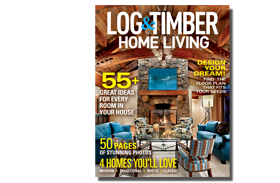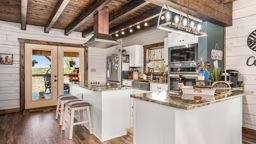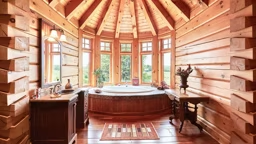
Great Room
For an intimate yet spacious feel, the conversation area of a great room should be about 10 feet in diameter, then add any extra square footage (nooks, bump-outs, etc.) around that. For ideal circulation, the path between low objects (sofas, coffee tables) should be 18 inches. You may think that’s too narrow, but it’s plenty of room to maneuver.
See also: Three Great Rooms That Are Completely Awe-Inspiring

Dining Room
Your dining table should provide 2 feet of space per person. So, if you sit down to dinner with an average of six people at a time, you’ll need an 8-foot-long table (two people on each side and one at each head). From here, plan your dining area’s square footage to accommodate the table, sideboard, china cabinet or other furniture, then plan space to move around. If traffic will pass behind seated diners, allow at least 44 inches to walk by easily. If you simply need an edge pass, you can shrink that number down to 36 inches.
_11868_2023-06-01_16-13.jpg)
Photo: KCJ Studios / See more of this home here.
Kitchen
There are two kitchen approaches in modern log homes: The traditional work triangle (placing the stove, fridge and sink in a triangular pattern) or zone style, which creates pockets for specialized tasks, like baking, food prep, cooking and serving, within a free-flowing layout. The latter approach is somewhat open ended in terms of size allocations based on how you’ll use the space most frequently, but if you like geometry, the ideal area of the kitchen triangle should be no more than 26 feet, with no single leg measuring less than 4 feet.
See also: Inspiring Log Home Kitchens
 Photo: Edgewood
Photo: Edgewood
Bedroom
The minimum recommended size for a sleeping space is 10-by-10 feet, which is enough to accommodate a full-size bed, a dresser and possibly a chair — plenty of room for a young child or an occasional guest but not much more than that. As you plan your bedrooms, include at least 4 feet of space in front of closets for adequate dressing space and door swing. Also plan about 30 inches of clearance around large pieces of furniture for easy maneuverability. If you’re on a budget, take care not to over-design your master bedroom. Though an expansive suite looks luxurious, many people admit that, after having lived in their log home for a while, the extra space is a bit of a waste.
See also: These Five Bedrooms Guarantee a Restful Sleep
 Photo: Kristi Benson, courtesy of Timberpeg
Photo: Kristi Benson, courtesy of Timberpeg
Bathrooms
Plan for 30 inches of clearance from the front edge of one fixture to any opposite fixture or obstacle. The distance between the center line of two sink vanities should be at least 36 inches to avoid bumping into your partner as you share the bath.
See also: Five Opulent Log and Timber Bathrooms
Other Key Spaces
Entries
The clear opening of a doorway should be at least 34 inches — ideally 36 or even wider if you want to take possible future mobility issues into account. And the average person requires 3 to 5 feet of space to comfortably remove a coat, so keep in mind the number of people who will use the entry on a regular basis.
Hallways
In open-concept plans, hallways are often eliminated, but if you will have a few in your design, make sure they’re at least 3 feet wide (an entry hall should be 40 inches wide at a minimum).
Closets
A simple wall closet should have a depth of at least 3 feet. When it comes to walk-ins, all bets are off. Depending on the size of your wardrobe and your budget, a walk-in closet can run the gamut between a simple square space to an upscale dressing room.
Garage
A one-car garage will need to be at least 10-by-20 feet; two cars require a 20-by-20 space at a minimum. But these numbers will simply allow you to park. They won’t accommodate all the other stuff (lawn mowers, bikes, holiday decor) that tends to be stored in the garage. Consider adding a half-garage to your plan for all the extras. And if you prefer oversized SUVs as your mode of transport, let your designer know. You’ll likely need additional width and door clearance.
See also: How Log Home Trends Have Evolved











